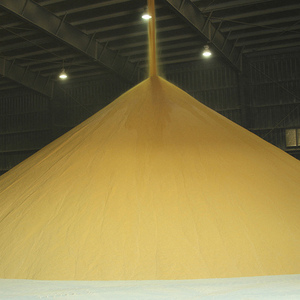Platts publishes price assessments for DDGS

FILE PHOTO
October 2, 2015
BY Platts
Platts, a global provider of energy and commodities information, has began publishing price assessments for a key ethanol coproduct increasingly used as animal feed in the United States and globally.
The new references are for dried distillers grains with solubles (DDGS) and reflect values for the Midwest, the nation’s key corn, wheat and grains producing region, and exportable values at the U.S. Gulf Coast.
“With U.S. ethanol production beyond 340 million barrels in 2014, 90 percent of which was produced through the dry-mill process, it’s easy to understand the market’s heightened desire for an independent source of pricing data for the burgeoning DDGS-as-feed market,” said Sophie Byron, Platts managing editor, Americas agriculture.
“Platts’ long experience in price discovery processes in oil and refined products and the expertise in sugar as a biofuel that we gained with our 2012 acquisition of sugar specialty company Kingsman, uniquely positions us to answer the market’s call.”
Advertisement
Exports of DDGS, increasingly used as feed for beef and dairy cattle, totaled more than 11 million metric tons in 2014, with buying interest concentrated in China and broader Asia.
“We believe the demand for feed substances in the U.S. and worldwide will only grow over time,” Byron said. “By having two assessments, one focused on the domestic price and the other on the export price, we’ll be providing buyers, sellers, traders and brokers the pricing insight they need to make better business decisions.”
The assessments are:
Advertisement
- Platts DDGS FOB Chicago: the physical spot market value of DDGS free on board (FOB) as delivered by 25-short-ton truck or rail-head to Channahon, Illinois, for the next week's delivery.
- Platts DDGS CIF New Orleans: the physical spot market value of DDGS 1500-short tons cost, insurance and freight as delivered on a barge to New Orleans and having loaded any period over the front month.
Both assessments reflect export-quality DDGS with a minimum protein content of 25 percent, color of 50, (a colorimetric measurement of nutritional value after exposure to heat), fat of 6 percent and a moisture level of 10 to 12 percent.
“We have been in discussions with the industry and marketplace about these assessments for more than a year and they’re the latest in a suite of spot market references we’ve designed to improve the transparency of price formation in the ethanol production chain,” said Andrew Goodwin. Platts vice president and general manager of agriculture, metals and petrochemicals.
Related Stories
The U.S. exported 31,160.5 metric tons of biodiesel and biodiesel blends of B30 and greater in May, according to data released by the USDA Foreign Agricultural Service on July 3. Biodiesel imports were 2,226.2 metric tons for the month.
CARB on June 27 announced amendments to the state’s LCFS regulations will take effect beginning on July 1. The amended regulations were approved by the agency in November 2024, but implementation was delayed due to regulatory clarity issues.
Legislation introduced in the California Senate on June 23 aims to cap the price of Low Carbon Fuel Standard credits as part of a larger effort to overhaul the state’s fuel regulations and mitigate rising gas prices.
The government of Brazil on June 25 announced it will increase the mandatory blend of ethanol in gasoline from 27% to 30% and the mandatory blend of biodiesel in diesel from 14% to 15%, effective Aug. 1.
The U.S. EIA reduced its 2025 and 2026 production forecasts for a category of biofuels that includes SAF in its latest Short-Term Energy Outlook, released June 10. The forecast for 2025 renewable diesel production was also revised down.
Upcoming Events









